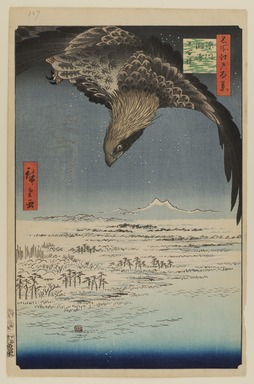
Artist:Utagawa Hiroshige
Medium: Woodblock print
Geograhical Locations:
Dates:5th month of 1857
Dimensions: Sheet: 14 3/16 x 9 1/4 in. (36 x 23.5 cm) Image: 13 3/8 x 8 3/4 in. (34 x 22.2 cm)
Collections:
Exhibitions:
Accession Number: 30.1478.107
Image: 30.1478.107_PS20.jpg,
Catalogue Description: This print is one of the three most often cited as favorites in the series, along with the Rain at Ohashi (print 58) and the Foxfires at Oji (print 118). There is a particular appeal in the powerful form of the eagle as it prepares to dive for prey in the wintry marshes below. The back of the eagle is enhanced with glinting mica and the three claws seen here are coated in shiny gloss. In the distance is the snow-capped form of Mount Tsukuba. Fukagawa Susaki was a portion of land along Edo Bay that had a popular Benten shrine at the tip and that also offered excellent shellfish gathering at low tide in the spring. The view here is from Fukagawa Susaki toward Jumantsubo, a large tract of land that corresponds to the present Senda and Sengoku 2-3 chome neighborhoods in Koto Ward. This area was reclaimed from the marshes in 1723-1726 and named after its approximate area. In Hiroshige's time it was occupied in part by one of the suburban daimyo estates.